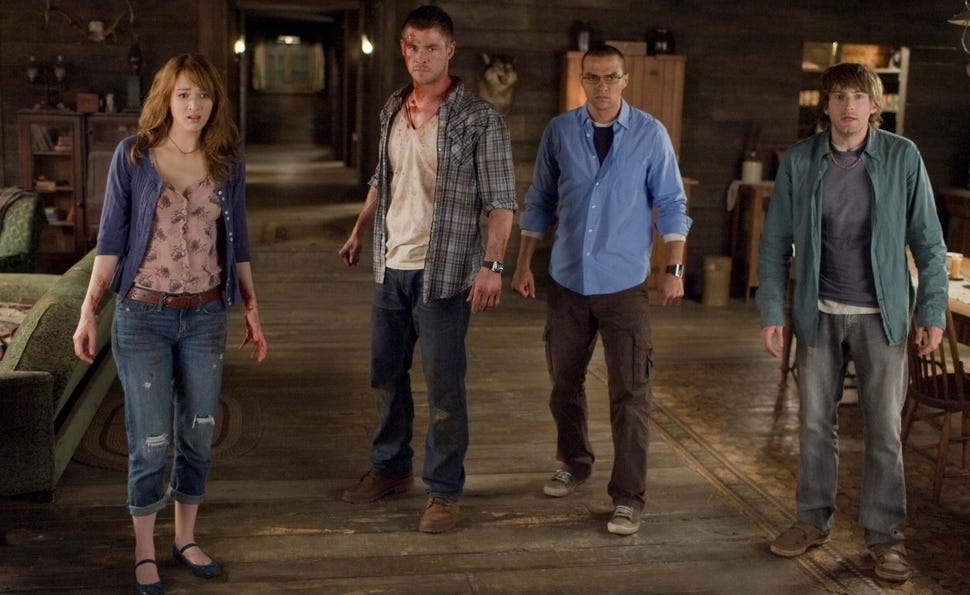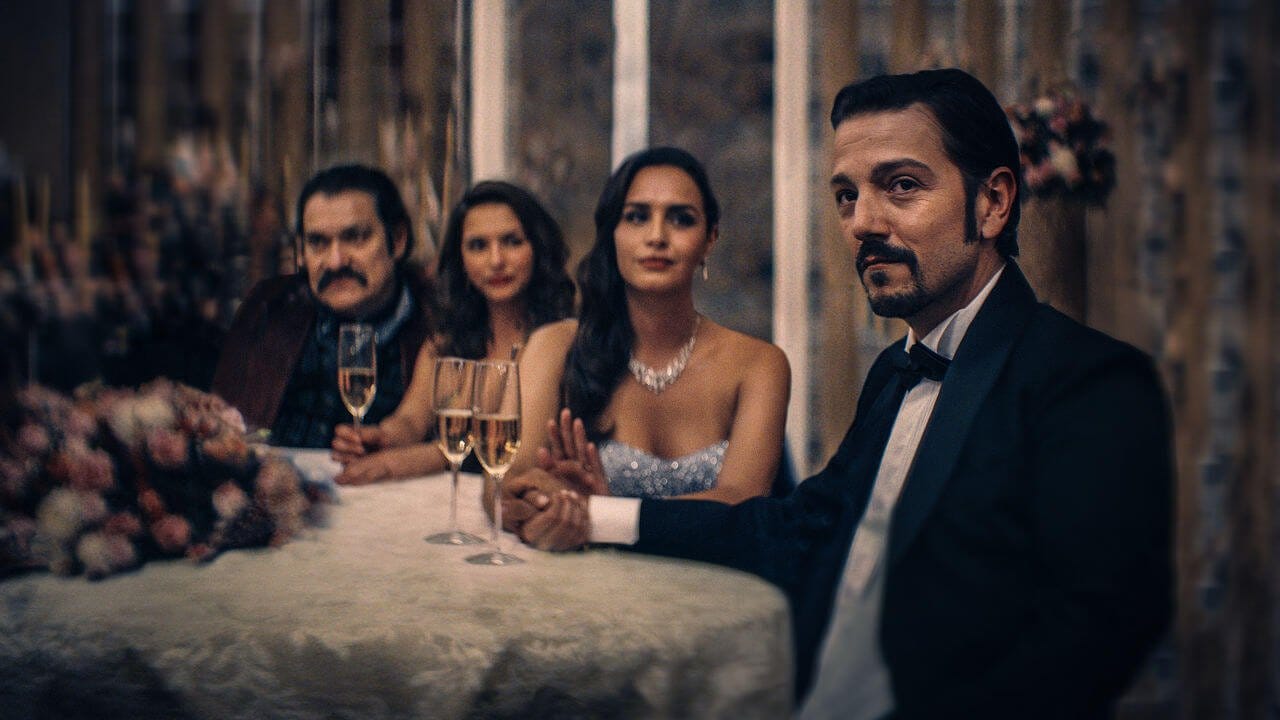Spoiler Alert! Movies with Major Twists Streaming Now
Plus: We recommend a podcast, and a new season of Narcos hits Netflix

A great plot twist is hard to pull off, but incredibly satisfying when done right. We have a few of those for you below, including two horror movies and a classic 90s crime flick. Since it’s hard to write about movies with major twists without spoiling them, we have added a spoilers warning in big bold letters before we get to discussing the twist. If you haven’t seen the movie, you’re safe to read until you get there.
But first, we need to shout out a new podcast before we do our weekly recommendations. A few of our “friends” started The CineBoiz Podcast. Fair warning: There is a social media beef between this pod and Do You Like Apples, so if you take their side, you’re dead to us. However, if you enjoy fun conversation about movies, I guess you should give it a listen. You can find The CineBoiz Podcast on all the major podcast outlets (Apple, Spotify, Google, etc.), and you can follow them on Facebook, Twitter, and Instagram.
Billy recommends…
The Cabin in the Woods (streaming on Amazon Prime)
This is a top 10 “this is not what I expected” movie. The title even makes one cringe. The Cabin in the Woods? A cliche horror movie with dumb teenagers who are actually in their 30s in real life? Turns out it is right up my alley. A twist is much needed for a premise that has been overdone, and luckily that twist delivers the goods.
Director Drew Goddard is an enigma in the Hollywood industry. He has a style that is ripe for stardom, but each effort has slightly missed the mark for audiences. Not in positive reception, but in box office numbers. All of his movies and TV shows have pop culture, nostalgia, and stars throughout and allow each actor to have so much fun on screen. The Cabin in the Woods is truly one of the most fun experiences anyone can have watching a movie. Sure, the themes are horror-based, and that is not for everyone. Luckily for the wimps out there, there is a twist right at the beginning of the movie that sets in motion a source for every single horror movie ever made.
**BEWARE! SPOILERS AHEAD**
Our opening scene zooms in on three scientist-looking characters that exposition the shit out of the first scene with a flair of energy that sets a specific tone. Now the twist builds on itself as the story goes along, so don’t worry that I spoiled the premise. Plenty of surprises are in store. The Cabin in the Woods connects a lot because these scientist characters are tasked with sending our worst nightmares to kill the classic cliche movie characters. The jock, cute nerd, promiscuous love interest, token black guy, and the comedic relief pothead. So theoretically, Halloween, Friday the 13th, and Texas Chainsaw Massacre could have been created by these evil masterminds. The premise is finally set and the fun finally begins. Our commonly seen characters choose what creatures are going to kill them and their motivations are explained in wonderfully silly ways. In turn it gets rid of the things we yell at the screen while watching a horror movie. “Get out of there!” “What are you doing!?” “No one would actually do that!”
Goddard has that flare to him in all of his movies and The Cabin in the Woods is our first taste, and best effort, at creating an entertaining experience that is riddled with references and nostalgia to keep any generation interested. Those aspects allow the most horror-averse moviegoers to suffer through the spooks because there is a wink at the camera throughout. Ideally, you will sit down with a group of friends and put this fun journey on. The jump scares will bring you close to the love of your life and the laughs will keep the party going well after the credits are done.
Drew recommends…
Us (streaming on HBO)
I’ve been wrestling with Jordan Peele’s Us since I saw it almost a year ago. Sometimes I think it’s a brilliant and frightening allegory, and other times I’m frustrated by a movie that might try to do too much. You can certainly watch it only as a fun horror-comedy, but there’s no doubt that writer-director Jordan Peele has embedded quite a bit of messaging just below the surface. It’s up to us (no pun intended) to decipher what exactly he’s saying. Even if you think the metaphor gets jumbled, this much is true: Us has an electrifying twist ending.
Before we get to that, I first have to note how engaging this movie is on every level. The performances are excellent across the board, but the most credit has to go to Lupita Nyong’o. Every character has a doppelganger in Us, but her characters (Adelaide and Red) get the most screen time. Nyong’o impressively presents both of them in a memorably haunting performance. The range she showcases is unbelievable.
The story is also wildly engaging. Peele smartly fashioned Us to work as a scary home invasion thriller, as well as a subtle (and occasionally not-so-subtle) look at race, class, and trauma. In addition to crafting truly chilling images, Peele employs a tone-setting score and soundtrack that is just the right amount of creepy and self-aware (you’ll never hear “I Got 5 On It” the same way ever again). While the first half of the film contains many of the horror film hallmarks we’ve come to love, the second half dives beneath the surface (literally) to get at deeper ideas about our country and ourselves.
**BEWARE! SPOILERS AHEAD!**
No matter what you think about the ending, Us is fascinating because of how much discussion it sparks. When I went to see this with a few friends, we immediately walked to a bar to talk through what we had just seen over drinks. We were confounded by it, but also interested to figure out what it all meant, which is why the twist at the end is so effective.
When Adelaide kills her doppelganger in the abandoned tunnels, we momentarily think our hero has come out ahead. However, in the final scene Adelaide has a flashback to the night she entered a carnival hall of mirrors as a child and came face to face with herself. We discover that her doppelganger forcibly took her place, revealing that the real Adelaide has been underground this whole time, leading the “Tethered” to the revolution happening now. As her son Jason appears to realize this, we see an overhead shot of a very long chain of Tethered holding hands in unison across the California terrain (a la Hands Across America). Boom, credits. I still remember the chill that rocketed down my spine.
So, what does it all mean, man? Well, unlike Peele’s ingenious debut Get Out, which was clearly about race, Us could mean many things, depending on your interpretation. You could read it as a critique of America’s class structure and the marginalization of the less fortunate that is baked into it. In an early scene the Tethered call themselves “Americans,” which could be a tell-tale sign that they are meant to represent the poor that are so often ignored by everyday people. The title of the film could easily be seen as U.S., or United States.
You could also read the movie as an allegory about trauma, both experiential and inherited. Adelaide is clearly struggling with childhood trauma throughout (until we realize she’s not Adelaide). Us is also riffing on our nation’s inherited trauma from its historical sins of genocide and slavery. Peele has created a world, mirroring our own, where we overlook the horrors of our shared past so that we can tell a new, more palatable story. (You can read a deeper analysis of this interpretation here.)
Finally, I think the one interpretation that stuck with me the most after I saw Us was a broader one, but no less impactful. Everyone in the movie has a dark and twisted doppelganger, which represents the side of ourselves that we don’t usually let the world see, but very much exists. It’s the ugly version that leads to all kinds of terrible things: cruelty, apathy, racism, greed, etc. This the selfish and sinful part of each of us that we should be working against, not by ignoring this inconvenient fact, but by acknowledging it and facing it head on to become our better selves.
The Usual Suspects (streaming on HBO)
Other than The Sixth Sense, this is the 90s movie most known for its huge game-changing twist. Rewatching it recently, I have to say I was not quite as impressed as the first time I saw it. The acting is pretty good and the story structure keeps you engaged, but I’m not sure the actual plot is all that interesting -- and I love a good crime story as much as anyone.
(It’s also true that the legacy of The Usual Suspects has gotten a lot more complicated lately, due to multiple sexual assault allegations against both star Kevin Spacey and director Bryan Singer. We’ll save the “Can we enjoy entertainment made by bad people?” conversation for another day.)
The original myth around The Usual Suspects came from its hammer of a twist at the very end, so let’s talk about that.
**BEWARE! SPOILERS AHEAD!**
I’m pretty sure I had this famous twist ruined for me before I even saw it, which sucks, but that doesn’t mean this movie isn’t worth watching. The Usual Suspects is a classic “unreliable narrator” movie, in that it shows you what happened in the opening scene and then has a character (Spacey’s Verbal Kint) tell you a lie for most of the movie. It’s not until the last gasp that you find out that weak and ineffectual Verbal is criminal mastermind Keyser Soze.
It’s a Big Twist that has been blowing viewers’ minds for 25 years, even if it’s widely known now. My main complaint of the movie isn’t the twist, but most of what leads up to it. While the dialogue is interesting enough (even if you can’t understand a word Benicio del Toro’s character is saying), the story kind of flashes by in a forgettable way. It’s not until Kujan sees “Kobayashi” on the bottom of the coffee mug that you start to rethink everything you’ve seen.
Maybe The Usual Suspects has become victim to what has plagued other famous Big Twist movies, like The Sixth Sense and Psycho. At a certain point, the cultural impact of the twist starts to overshadow the story itself.
Streaming TV Corner
What we’re watching this week
Drew: Narcos: Mexico (streaming on Netflix)

Everyone has that one show that they could watch forever, no matter where the story goes or how much the quality varies. For me, that show is Narcos. Netflix could make 50 seasons of Narcos (and they honestly might) and I would watch every second. The second season of Narcos: Mexico dropped last week. The Mexico-set seasons of the show have not been quite as good as the first three Colombian seasons. Diego Luna’s Felix Gallardo doesn’t have the larger-than-life drug kingpin mythos of Pablo Escobar, but this season still has all the familiar elements that make Narcos so perennially watchable.


